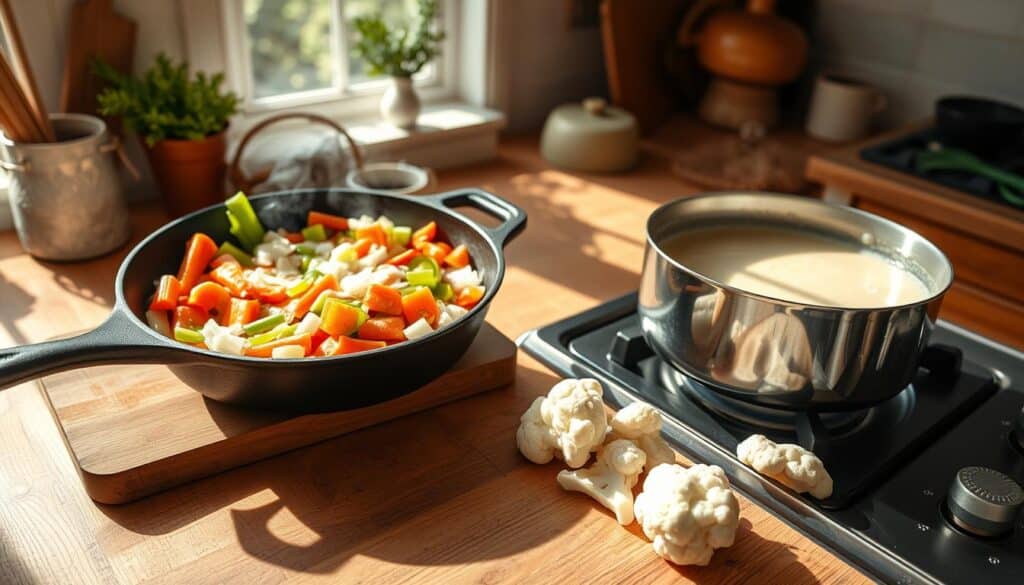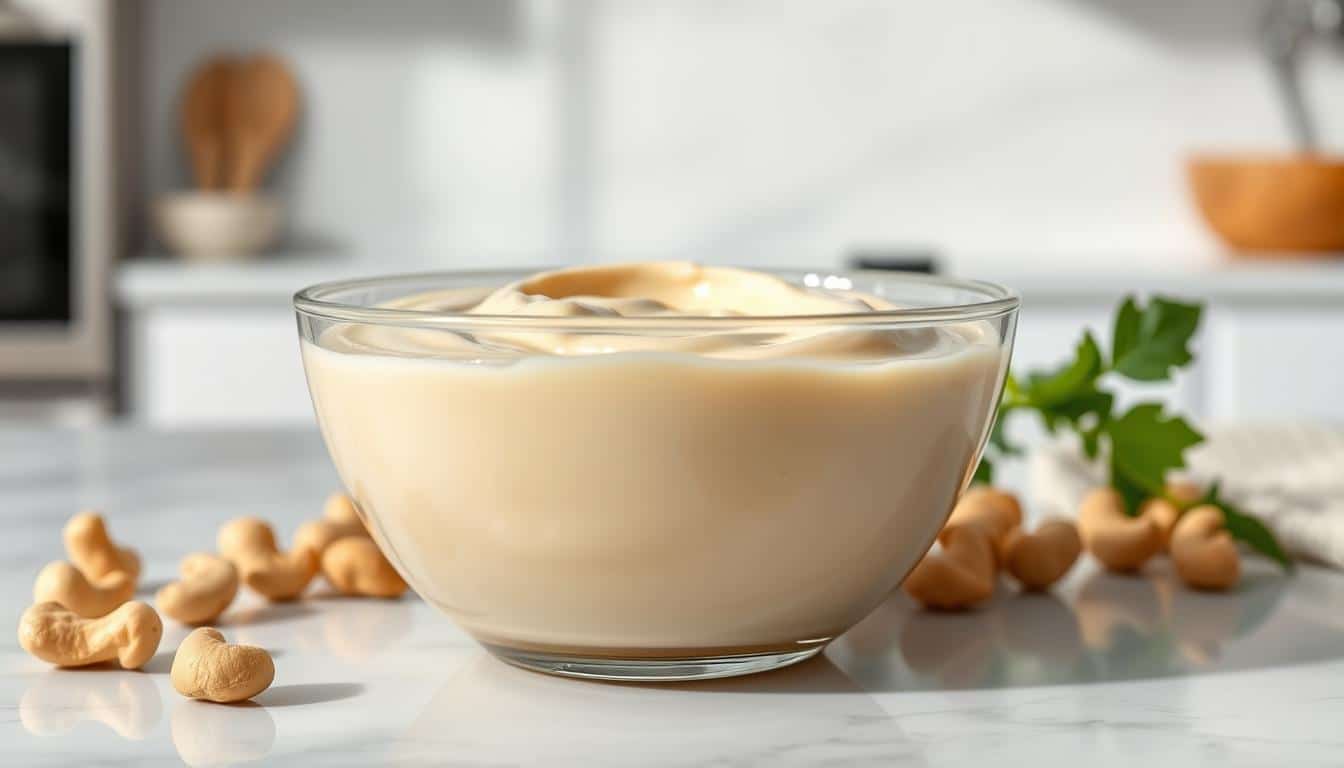easy to make. There’s something special about a warm, comforting bowl of homemade soup that feels like a big hug on a chilly day. For me, that hug comes in the form of my creamy cauliflower soup, a recipe I’ve perfected over the years. It’s a dish that’s not only easy to make but also packed with flavor, and the best part? No heavy cream required!
Thank you for reading this post, don't forget to subscribe!I remember the first time I tried making cauliflower soup. I was skeptical—could something so simple really be delicious? But one sip, and I was hooked. The key, I discovered, is in the details: roasting the cauliflower first to bring out its natural sweetness and then blending it to create a silky smooth texture. It’s a game-changer.
This recipe is a staple in my kitchen, especially during the cooler months. With just a few ingredients like cauliflower, broth, and a touch of olive oil, it’s both nourishing and satisfying. Plus, it’s ready in about 30 minutes, making it a perfect option for a quick, hearty meal.
What I love most about this soup is how it balances simplicity with depth of flavor. Every step, from sautéing the garlic to simmering the roasted cauliflower, is designed to enhance the natural taste of the ingredients. And let’s not forget the versatility—whether you’re serving it as a starter or a main meal, it never disappoints.
Ready to give it a try? Let’s dive into my personal twist on this classic recipe and make a pot of deliciousness that your taste buds will thank you for. For more inspiration, check out these easy soup recipes that are perfect for any occasion.

Key Takeaways
- A simple, creamy cauliflower soup recipe without heavy cream.
- Roasting cauliflower enhances its flavor and texture.
- Ready in 30 minutes for a quick, hearty meal.
- Packed with nutrients and natural flavors.
- Perfect for a comforting meal any time of the year.
Introduction: My Cozy Cauliflower Soup Journey
There’s a certain charm to a warm, comforting bowl of homemade soup that feels like a gentle embrace on a chilly day. For me, that embrace comes in the form of my creamy cauliflower soup, a recipe I’ve perfected over the years. It’s a dish that’s not only easy to make but also packed with flavor, and the best part? No heavy cream required!
I remember the first time I tried making cauliflower soup. I was skeptical—could something so simple really be delicious? But one sip, and I was hooked. The key, I discovered, is in the details: roasting the cauliflower first to bring out its natural sweetness and then blending it to create a silky smooth texture. It’s a game-changer.
This recipe is a staple in my kitchen, especially during the cooler months. With just a few ingredients like cauliflower, broth, and a touch of olive oil, it’s both nourishing and satisfying. Plus, it’s ready in about 30 minutes, making it a perfect option for a quick, hearty meal.
What I love most about this soup is how it balances simplicity with depth of flavor. Every step, from sautéing the garlic to simmering the roasted cauliflower, is designed to enhance the natural taste of the ingredients. And let’s not forget the versatility—whether you’re serving it as a starter or a main meal, it never disappoints.
Ready to give it a try? Let’s dive into my personal twist on this classic recipe and make a pot of deliciousness that your taste buds will thank you for. For more inspiration, check out these easy soup recipes that are perfect for any occasion.
Essential Ingredients and Must-Have Tools
Creating a delicious and creamy cauliflower soup starts with the right ingredients and tools. Quality matters, so let’s break down what you’ll need.
Key Ingredients: Cauliflower, Broth, and Fresh Herbs
- A full head of fresh, high-quality cauliflower is the star of the show.
- Flavorful vegetable broth adds depth without extra cream.
- Fresh herbs like parsley and thyme bring brightness and aroma.
Each ingredient plays a vital role. The cauliflower provides natural sweetness, while the broth and herbs enhance the flavor profile. Precise measurements ensure balance, making every bite a delight.
Kitchen Tools for a Smooth Cooking Process
- A sturdy Dutch oven or pot is perfect for simmering.
- A reliable blender (like a Vitamix) ensures a silky texture.
Good tools make cooking easier. Keep your blender clean by rinsing it immediately after use. A little care goes a long way in maintaining your kitchen essentials.
Prepping and Roasting Your Cauliflower
Prepping and roasting cauliflower is where the magic begins. This step is crucial for bringing out its natural sweetness and setting the flavor foundation for the soup.
Selecting and Preparing the Cauliflower Head
Start by choosing a fresh, firm head of cauliflower with no signs of browning. Cut it into florets, making sure to include some of the core for texture. This balance ensures a hearty and smooth soup.
Roasting Techniques to Enhance Flavor
Toss the florets with olive oil and a pinch of salt, then spread them on a parchment-lined tray. Roast in a preheated oven at 425°F for 25-35 minutes, turning halfway. The cauliflower is ready when tender and caramelized, with browned edges.
Roasting deepens the cauliflower’s sweetness and adds a smoky note. This step is essential for a flavorful soup. Plus, using parchment paper makes cleanup a breeze!
Building Layers of Flavor Through Sautéing and Simmering
The foundation of a great cauliflower soup lies in the layers of flavor created during the sautéing and simmering processes. These steps transform simple ingredients into a rich, aromatic dish that feels like a warm embrace on a chilly day.
Sautéing Onions, Garlic, and Other Vegetables
Sautéing is where the magic begins. By gently sweating onions and garlic, you unlock their natural sweetness, which adds depth to the soup. I also like to add a few diced carrots and celery for extra complexity. This step is all about building a flavorful base that complements the roasted cauliflower beautifully.

Simmering with Broth and Spices for Depth
Once the aromatics are tender, it’s time to add the roasted cauliflower and vegetable broth. A wide-mouth pot is ideal here, as it allows the flavors to meld evenly. I season with a pinch of salt, a grind of pepper, and a touch of nutmeg for warmth. Let it simmer for about 20 minutes, allowing the ingredients to infuse their flavors into the broth.
During this time, the soup develops a lush, layered base. Stir occasionally to ensure nothing sticks, and adjust the heat to maintain a gentle simmer. This balance of roasted and fresh elements creates a harmonious taste that’s both comforting and refined.
For more tips on perfecting this technique, check out this cauliflower soup recipe.
Cauliflower Soup Recipe: Tips & Techniques
Mastering the art of cauliflower soup involves more than just following a recipe—it’s about understanding the techniques that elevate each ingredient. Whether you’re a seasoned chef or a kitchen newbie, these tips will help you create a truly exceptional dish.
Achieving a Creamy Texture without Heavy Cream
The secret to a luxurious texture lies in your blending technique. Roasted cauliflower becomes tender and caramelized, making it perfect for blending. I recommend using a high-powered stand blender for the smoothest results. Add a tablespoon of butter (or cashews for a vegan option) to enhance creaminess without heavy cream. After blending, stir in spices like nutmeg or a squeeze of lemon juice to preserve their vibrant flavors.
Using an Immersion vs. a Stand Blender
Choosing the right blender can make all the difference. A stand blender offers a silky smooth texture, ideal for this recipe. However, an immersion blender is great for smaller batches and convenience. Both methods work well, so pick what suits you best!
| Blender Type | Pros | Cons |
|---|---|---|
| Stand Blender | Ultra-smooth texture, powerful blending | Requires more cleanup |
| Immersion Blender | Convenient, easy to use | May not blend as smoothly |
For the best results, blend roasted cauliflower thoroughly and adjust seasoning with a pinch of salt and pepper. Cleaning your blender immediately after use prevents food from sticking. If the texture isn’t smooth, blend a little longer or add a touch more broth. These small steps ensure a perfect, creamy soup every time.
Exploring Variations: Dairy-Free and Vegan Options
For those following a dairy-free or vegan diet, achieving a creamy texture without traditional dairy can be a challenge. However, with a few simple substitutions, you can enjoy a rich and satisfying version of this beloved soup.
Substituting Butter with Cashews
One of my favorite hacks is using cashews as a dairy alternative. Soak 1/2 cup of cashews in water for about 4-6 hours until they soften. After soaking, blend them with 1/4 cup fresh water until smooth. This creates a creamy base that’s perfect for our soup. For an extra touch, you can add a splash of lemon juice to brighten the flavor.

Adjusting Seasonings to Suit Dietary Needs
Seasoning plays a crucial role in maintaining flavor integrity, especially in vegan versions. I recommend using a pinch of salt, a grind of pepper, and a squeeze of fresh lemon juice to enhance the natural flavors. For added depth, try incorporating herbs like parsley or thyme. These small tweaks ensure the soup remains vibrant and delicious, even without dairy.
Experimenting with plant-based ingredients can also elevate your soup. Consider adding a splash of olive oil or a sprinkle of nutritional yeast for extra richness. The result is a luscious, hearty soup that’s just as satisfying as its traditional counterpart.
For more inspiration on dairy-free soups, check out this vegan cauliflower soup recipe that’s both gluten-free and keto-friendly. It’s a perfect example of how creativity can lead to a truly exceptional dish.
Serving Suggestions and Complementary Pairings
Transforming your bowl of creamy cauliflower soup into a complete meal is all about the right accompaniments. Whether you’re looking for a quick lunch or a cozy dinner, these serving suggestions will elevate your dining experience.
Garnishing Ideas for a Fresh Finish
Add a vibrant touch to your soup with fresh herbs. Chopped parsley, green onions, or microgreens create a pop of color and freshness. A sprinkle of grated Parmesan or a dollop of sour cream can add richness and texture, making each spoonful more satisfying.
Side Dishes That Enhance the Meal
- Pair the soup with a crusty loaf of bread or homemade croutons for a delightful textural contrast.
- A simple green salad with mixed greens and a light vinaigrette provides a refreshing balance to the richness of the soup.
- For a hearty option, try roasted butternut squash or sweet potato fries, which complement the soup’s creamy texture with their natural sweetness.
My personal favorite is serving the soup with a side of garlic bread. The combination of the warm, aromatic bread and the smooth soup is absolutely delightful. For a lighter option, a crisp spinach and strawberry salad adds a fruity and fresh contrast that complements the savory flavors of the soup.
Enhance your meal with these thoughtful pairings and make every bowl of soup a memorable experience. The right garnishes and sides can turn a simple dish into a gourmet delight!
Conclusion
As you savor the last spoonful of this comforting dish, remember how simple it is to create such rich flavors. This recipe combines roasted cauliflower, aromatic garlic, and a touch of salt and pepper to craft a meal that’s both nourishing and delicious.
With just a few ingredients and about an hour, you can enjoy a hearty soup that’s perfect for any day. Roasting the cauliflower brings out its natural sweetness, while a blend of spices adds depth. The best part? It’s ready in under an hour and serves 4-6 people, making it ideal for sharing or storing for later.
Feel free to experiment with variations—whether you’re using cashews for a vegan twist or adding a splash of olive oil for extra richness. Store leftovers in the fridge for up to 5 days or freeze for up to 3 months for a quick, comforting meal whenever you need it.
I hope you enjoy this recipe as much as I do! Let me know in the comments how it turns out and any creative twists you add. Happy cooking, and until next time, warm regards from my kitchen to yours!
FAQ
How can I make roasted cauliflower taste better?
To enhance the flavor of roasted cauliflower, toss the florets with olive oil, garlic, salt, and pepper before roasting. You can also add a sprinkle of cheese or a pinch of your favorite spices for extra flavor.
Can I make this recipe without cream?
Absolutely! You can substitute cream with milk or a dairy-free alternative like cashews blended with water for a creamy texture. This keeps the soup light and just as delicious.
What’s the best way to blend the soup smoothly?
For the smoothest results, use an immersion blender right in the pot. If you prefer a stand blender, blend in small batches to avoid overflow and ensure even consistency.
How do I prevent the soup from being too bland?
Add depth by sautéing onions and garlic before simmering. You can also roast the cauliflower first to bring out its natural sweetness and enhance the overall flavor.
Can I make this soup ahead of time?
Yes! Prepare the soup up to a day in advance and store it in the fridge. Reheat it gently over medium heat before serving. Add a splash of broth if it thickens too much.
What if I don’t have vegetable broth?
You can use chicken broth or even water as a substitute. For added flavor, toss in some fresh herbs or spices while simmering to make up for the lack of broth.
How can I make the soup dairy-free?
Replace dairy products with non-dairy milk like almond or oat milk. You can also use olive oil instead of butter for sautéing. This makes the recipe vegan-friendly too!
What’s the best way to thicken the soup?
Let it simmer longer to reduce the liquid, or blend in some roasted cauliflower for extra thickness. You can also add a tablespoon of flour or cornstarch mixed with water for a quick fix.
Can I customize the recipe with other vegetables?
Feel free to add your favorite vegetables like carrots or celery while sautéing. This adds texture and flavor, making the soup even heartier.
How do I store leftovers?
Cool the soup completely, then transfer it to an airtight container. Store it in the fridge for up to 3 days or freeze for up to a month. Reheat gently when ready to serve.
Can I make this recipe in under 30 minutes?
Yes! Skip the roasting step and sauté the cauliflower directly in the pot. This cuts down on time while still delivering a delicious meal.
What’s the best cheese to use for topping?
Cheddar, Parmesan, or even a sprinkle of feta work beautifully. For a dairy-free option, try nutritional yeast for a cheesy flavor without the dairy.
There are no reviews yet. Be the first one to write one.

